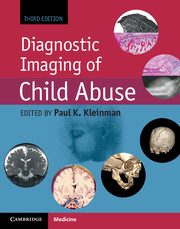Book contents
- Frontmatter
- Dedication
- Contents
- List of Contributors
- Editor’s note on the Foreword to the third edition
- Foreword to the third edition
- Foreword to the second edition
- Foreword to the first edition
- Preface
- Acknowledgments
- List of acronyms
- Introduction
- Section I Skeletal trauma
- Chapter 1 The skeleton: structure, growth and development, and basis of skeletal injury
- Chapter 2 Skeletal trauma: general considerations
- Chapter 3 Lower extremity trauma
- Chapter 4 Upper extremity trauma
- Chapter 5 Bony thoracic trauma
- Chapter 6 Dating fractures
- Chapter 7 Differential diagnosis I: diseases, dysplasias, and syndromes
- Chapter 8 Differential diagnosis II: disorders of calcium and phosphorus metabolism
- Chapter 9 Differential diagnosis III: osteogenesis imperfecta
- Chapter 10 Differential diagnosis IV: accidental trauma
- Chapter 11 Differential diagnosis V: obstetric trauma
- Chapter 12 Differential diagnosis VI: normal variants
- Chapter 13 Evidence-based radiology and child abuse
- Chapter 14 Skeletal imaging strategies
- Chapter 15 Postmortem skeletal imaging
- Section II Abusive head and spinal trauma
- Section III Visceral trauma and miscellaneous abuse and neglect
- Section IV Diagnostic imaging of abuse in societal context
- Section V Technical considerations and dosimetry
- Index
- References
Chapter 12 - Differential diagnosis VI: normal variants
from Section I - Skeletal trauma
Published online by Cambridge University Press: 05 September 2015
- Frontmatter
- Dedication
- Contents
- List of Contributors
- Editor’s note on the Foreword to the third edition
- Foreword to the third edition
- Foreword to the second edition
- Foreword to the first edition
- Preface
- Acknowledgments
- List of acronyms
- Introduction
- Section I Skeletal trauma
- Chapter 1 The skeleton: structure, growth and development, and basis of skeletal injury
- Chapter 2 Skeletal trauma: general considerations
- Chapter 3 Lower extremity trauma
- Chapter 4 Upper extremity trauma
- Chapter 5 Bony thoracic trauma
- Chapter 6 Dating fractures
- Chapter 7 Differential diagnosis I: diseases, dysplasias, and syndromes
- Chapter 8 Differential diagnosis II: disorders of calcium and phosphorus metabolism
- Chapter 9 Differential diagnosis III: osteogenesis imperfecta
- Chapter 10 Differential diagnosis IV: accidental trauma
- Chapter 11 Differential diagnosis V: obstetric trauma
- Chapter 12 Differential diagnosis VI: normal variants
- Chapter 13 Evidence-based radiology and child abuse
- Chapter 14 Skeletal imaging strategies
- Chapter 15 Postmortem skeletal imaging
- Section II Abusive head and spinal trauma
- Section III Visceral trauma and miscellaneous abuse and neglect
- Section IV Diagnostic imaging of abuse in societal context
- Section V Technical considerations and dosimetry
- Index
- References
Summary
Introduction
The young skeleton manifests a wide variety of developmental variants that may suggest the possibility of traumatic injury on imaging studies. Additionally, normal osseous structures may project radiographically in a manner that spuriously suggests injury, and in the absence of a history of accidental trauma to explain the findings, abuse may be considered (1). To avoid confusion, the radiologist must be familiar with these vagaries and the features that distinguish them from traumatic injury. This chapter focuses on the developmental variants and misleading images encountered in infancy and early childhood that may mimic inflicted injury. The discussion is not all inclusive and the reader is referred to well-known texts for a broader presentation of normal variations of the developing skeleton (2–4).
Physiologic subperiosteal new bone formation
Physiologic subperiosteal new bone formation (SPNBF) has been long recognized as a normal finding in young infants (5, 6). It involves the femur, humerus, and tibia and less commonly the ulna and radius (Figs. 12.1–12.6). Glaser found SPNBF in 47% of full-term infants and 39% of premature infants undergoing sequential radiographs between 1 and 6 months of age (5). Shopfner noted that the subperiosteal new bone initially produced a hazy, mineralized linear density paralleling an underlying normal cortex (6). With time, this layer of new bone becomes more discretely visible, producing a double contour of the cortex as described (5).
- Type
- Chapter
- Information
- Diagnostic Imaging of Child Abuse , pp. 290 - 308Publisher: Cambridge University PressPrint publication year: 2015



